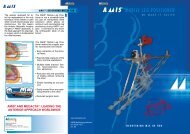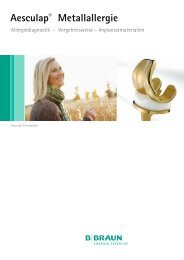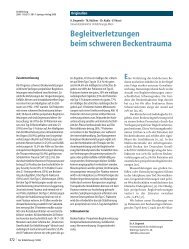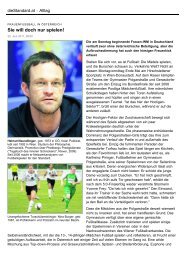Symposium on Muscle injuries ESSKA Congress 2006 Innsbruck ...
Symposium on Muscle injuries ESSKA Congress 2006 Innsbruck ...
Symposium on Muscle injuries ESSKA Congress 2006 Innsbruck ...
Create successful ePaper yourself
Turn your PDF publications into a flip-book with our unique Google optimized e-Paper software.
<str<strong>on</strong>g>Symposium</str<strong>on</strong>g> <strong>on</strong> <strong>Muscle</strong> <strong>injuries</strong><br />
<strong>ESSKA</strong> C<strong>on</strong>gress <strong>2006</strong> <strong>Innsbruck</strong><br />
SPORTS COMMITTEE<br />
Epidemiology and classificati<strong>on</strong> p2<br />
Thomas Muellner, Austria<br />
C<strong>on</strong>servative treatment p4<br />
Piero Volpi, Italy<br />
Operative treatment p6<br />
Sakari Orava, Finland<br />
Rehabilitati<strong>on</strong> p8<br />
Thomas Bochdanski, Austria<br />
Preventi<strong>on</strong> and future perspective not received<br />
Roald Bahr, Norway<br />
1
Epidemiology and Classificati<strong>on</strong><br />
Univ. Doz. Dr. Thomas Muellner, PhD<br />
Kupelwiesergasse 15, A-1130 Wien<br />
www.knieweh.at, office@knieweh.at<br />
<strong>Muscle</strong> <strong>injuries</strong> are <strong>on</strong>e of the most comm<strong>on</strong> <strong>injuries</strong> seen after sports activity. The incidence<br />
varies between 10% and 55% of all sustained <strong>injuries</strong>.<br />
c<strong>on</strong>sequently to a rupture near the<br />
musculo-tendinous juncti<strong>on</strong>.<br />
More <strong>injuries</strong> are seen during<br />
matches compared to training<br />
sessi<strong>on</strong>s. A muscle c<strong>on</strong>tusi<strong>on</strong> occurs<br />
when the muscle is hit by a direct<br />
blow comm<strong>on</strong> in c<strong>on</strong>tact sports.<br />
Possible risk factors for muscle <strong>injuries</strong> are<br />
age, a recent or a past injury of the same<br />
muscle, low flexibility, and others.<br />
Most <strong>injuries</strong> occur sudden after an<br />
extensive tensile force that leads to an<br />
overstraining of the myofibers and<br />
Onset<br />
Lacerati<strong>on</strong>s are rare reas<strong>on</strong>s for muscle <strong>injuries</strong> in the athletic populati<strong>on</strong>.<br />
The current clinical classificati<strong>on</strong> is based <strong>on</strong> the clinical impairment.<br />
Circumstances<br />
2
1 DOMS Delayed Onset <strong>Muscle</strong> Soreness: pain, swelling, and loss of strength and ROM<br />
after eccentric exercise, increase in intensity during first 24 h after exercise, peak intensity<br />
after 24 to 72 h<br />
2 Mild (first-degree) strain/c<strong>on</strong>tusi<strong>on</strong> : tear of <strong>on</strong>ly a few muscle fibers, minor swelling<br />
and discomfort, no or <strong>on</strong>ly minimal loss of strength and restricti<strong>on</strong> of the movements.<br />
3 Moderate (2nd-degree) strain/c<strong>on</strong>tusi<strong>on</strong>: greater damage of the muscle, clear loss in<br />
functi<strong>on</strong> (ability to c<strong>on</strong>tract)<br />
4 Severe (third-degree) strain/c<strong>on</strong>tusi<strong>on</strong>: a tear extending across the entire cross secti<strong>on</strong> ,<br />
virtually complete loss of muscle functi<strong>on</strong><br />
The clinical picture depends <strong>on</strong> the severity of the injury and the nature of the hematoma.<br />
The intramuscular blood vessels are torn relatively easily, so we can see inter- and<br />
intramuscular hematomas.<br />
3
CONSERVATIVE TREATMENT OF MUSCLE STRAINS<br />
Piero Volpi *, Gianluca Melegati **, Davide Tornese **<br />
* Sports Traumatology and Arthroscopic Surgery Unit<br />
** Center for Sports Rehabilitati<strong>on</strong><br />
Galeazzi Orthopaedics Institute – Milan - Italy<br />
<strong>Muscle</strong> <strong>injuries</strong> can be classified as:<br />
• Delayed Onset <strong>Muscle</strong> Soreness (DOMS)<br />
• Strains<br />
° I° DEGREE: local fibril and filament damage with no soluti<strong>on</strong> of c<strong>on</strong>tinuity<br />
° II° DEGREE: interrupti<strong>on</strong> of a certain number of muscles fibres without involvement of<br />
a grossly recognisable porti<strong>on</strong> of the belly<br />
° III° DEGREE: rupture of a large porti<strong>on</strong> of the belly with clinically evident soluti<strong>on</strong> of<br />
c<strong>on</strong>tinuity<br />
• C<strong>on</strong>tusi<strong>on</strong>s<br />
° intermuscular haematoma<br />
° intramuscular haematoma<br />
• Avulsi<strong>on</strong>s<br />
° osseous<br />
° apophyseal<br />
° muscular<br />
In the case of strains, the muscle-tend<strong>on</strong> juncti<strong>on</strong> is particularly at risk due to its lesser<br />
extensibility and the sudden reducti<strong>on</strong> of the local circulati<strong>on</strong> in the tend<strong>on</strong> compared with the<br />
muscle and the bi-articular muscles, especially the <strong>on</strong>es with greater number of type II, fastc<strong>on</strong>tracti<strong>on</strong><br />
fibres.<br />
Slight muscle <strong>injuries</strong> are repaired by m<strong>on</strong><strong>on</strong>uclear satellite cells that differentiate into<br />
myoblasts. More serious <strong>injuries</strong> are mainly repaired by the formati<strong>on</strong> of scar tissue. The way<br />
in which recovery of functi<strong>on</strong> progresses is of fundamental importance because it guides the<br />
correct repair of the newly formed tissue.<br />
An account will be given of the principles applicable during the rehabilitati<strong>on</strong> of a subject<br />
with a stage II injury. Three time phases are distinguished: the acute phase, remodelling and<br />
recovery of functi<strong>on</strong>.<br />
The first step requires applicati<strong>on</strong> of a compressive elastic bandage and local cryotherapy (20<br />
min/hr). This phase is marked by local haemorrhage, myofibrillar retracti<strong>on</strong> and oedema due<br />
to enhanced capillar permeability. The goal of the RICE (rest, ice, compressi<strong>on</strong> and elevati<strong>on</strong>)<br />
procedure is to limit the initial damage. N<strong>on</strong>steroidal anti-inflammatory drugs (NSAIDs),<br />
muscle relaxants and other drugs are not used. Pain, in fact, is not usually such as to require<br />
analgesic cover.<br />
After 24-48 hr marked oedema is associated with mechanical muscle weakness due to<br />
massive macrophage invasi<strong>on</strong>. An overaggressive approach at this stage may cause further<br />
tissue damage, prol<strong>on</strong>g the inflammati<strong>on</strong> and delay repair. The outstanding neuroreflex acti<strong>on</strong><br />
of transcutaneous electric nerve stimulati<strong>on</strong> (TENS) can be safely and effectively used to<br />
relieve pain. On the third day the bandage is removed for echography and magnetic res<strong>on</strong>ance<br />
imaging (MRI) if required. Thanks to its hydrodynamic, hydrostatic, proprioceptive and<br />
thermal effects idrokinesitherapy allow the commencement of active mobilisati<strong>on</strong> and<br />
reinstatement of the range of moti<strong>on</strong> (ROM).<br />
Initial remodelling starts <strong>on</strong> the 3rd-6th day when fibroblasts deposit collagen. Healing is<br />
4
encouraged by the capillary neovascularizati<strong>on</strong> thus induced since it brings the oxygen and<br />
nutrients needed for regenerative and reparative metabolism. Biostimulati<strong>on</strong> can be enhanced<br />
by the neodymium-YAG laser and the capacitive and resistive tranfer biostimulati<strong>on</strong> therapy<br />
(TECAR therapy), according to specific protocols and in the functi<strong>on</strong> of the echographic<br />
picture, though sufficient scientific evidence of their effectiveness is still lacking. Massage is<br />
not employed at this stage while isometric muscle c<strong>on</strong>tracti<strong>on</strong> is begun in the form of<br />
submaximal exercise below the pain threshold.<br />
During the advanced repair stage (7th-14th day), fibre regenerati<strong>on</strong> is accompanied by an<br />
approximately 50% loss of muscle strength compared with the situati<strong>on</strong> prior to the accident.<br />
This is thought to be more correctly attributable to the inflammatory nature of the repair<br />
process, as shown by oedema and pain, rather than a real reducti<strong>on</strong> of c<strong>on</strong>tractility. There is a<br />
high risk of recurrence in this stage; pain and functi<strong>on</strong> improve but the patient is still<br />
vulnerable structurally.<br />
When satisfactory elasticity is reached submaximal c<strong>on</strong>centric and then eccentric muscle<br />
strengthening is begun against manual resistance. Recovery and maintenance of tissue<br />
elasticity are achieved by means of specific passive stretching exercises.<br />
During functi<strong>on</strong>al recovery (15th-60th day), maturati<strong>on</strong> of collagen and full recovery of<br />
voluntary muscle c<strong>on</strong>trol mean rehabilitati<strong>on</strong> must be directed to the total recovery of strength<br />
and functi<strong>on</strong>al efficiency. Normal movement, complete muscle elasticity and painless<br />
maximum isometric c<strong>on</strong>tracti<strong>on</strong> are usually achieved by the 3rd or 4th week. The progress of<br />
fibre remodelling in the scar site is checked echographically at this time.<br />
In case of muscle strains in the lower limb it is adviseble commencement of running when the<br />
peak moment of force at 60°/sec. is not less than 70% of the other limb. This, however,<br />
requires the executi<strong>on</strong> of a maximum isokinetic test that could itself result in a recurrence. In<br />
additi<strong>on</strong>, the isokinetic dynamometer evaluates muscle strength in open kinetic chain and<br />
without loading. Joint kinematics in a close kinetic chain system and with loading, therefore,<br />
cannot be reproduced and this instrument cannot be used to evaluate the musculature's role as<br />
a dynamic joint stabiliser.<br />
Initially submaximal eccentric isokinetic work at increasing speeds (starting from 60°/sec.) is<br />
carried out no more than three times a week. Overloads are avoided to prevent muscle fatigue.<br />
Work at high angular velocities is the hub around which the rehabilitati<strong>on</strong> programme<br />
revolves.<br />
Electrostimulati<strong>on</strong>, in our opini<strong>on</strong>, is not appropriate and there is no evidence of its utility in<br />
the literature.<br />
Unlimited training is commenced when the strength values are not less than 80% of those of<br />
the other limb and there is no muscle fatigue after protracted exercise.<br />
Resumpti<strong>on</strong> of competitive sport is to be hoped when there has been a sufficient regaining of<br />
muscle force, strength and flexibility, and neuromuscular c<strong>on</strong>trol.<br />
Recurrence within two m<strong>on</strong>ths from the resumpti<strong>on</strong> of sport is a clear indicati<strong>on</strong> of the<br />
inappropriateness of the rehabilitati<strong>on</strong> programme employed.<br />
5
<strong>ESSKA</strong> C<strong>on</strong>gress. <strong>Innsbruck</strong>, <strong>2006</strong>, <strong>Muscle</strong> injury symposium<br />
Sakari Orava, professor, MD, PhD, orthopaedic surge<strong>on</strong><br />
Mehiläinen Hospital, Sports Clinic and Sports Trauma Research Center, Turku, Finland<br />
Operative treatment of muscle <strong>injuries</strong><br />
General indicati<strong>on</strong>s for surgical treatment of muscle <strong>injuries</strong> are grade III-IV (total) tears and<br />
inserti<strong>on</strong> or origin avulsi<strong>on</strong>s from b<strong>on</strong>e. Several partial tears need surgery, too. The tear may<br />
recur, excessive scar tissue grows at the site of injury, adhesi<strong>on</strong>s to other tissues develop,<br />
especially around the near lying nerves, or tendinosis, degenerati<strong>on</strong> and blood circulati<strong>on</strong><br />
disturbances follow. In some cases motoric or sensory nerves to muscles are injuried<br />
(stretching, compressi<strong>on</strong>, tears) and c<strong>on</strong>secutively weakness, el<strong>on</strong>gati<strong>on</strong>, atrophy and<br />
denervati<strong>on</strong> of the muscle or part of it may occur. Entrapment neuropathies or neuromas may<br />
follow. Surgical complicati<strong>on</strong>s may occur. Sometimes the lesi<strong>on</strong> itself has been so severe that<br />
the end result is not good. The presentati<strong>on</strong> is based <strong>on</strong> own experiences <strong>on</strong> muscle injury<br />
operati<strong>on</strong>s as well as <strong>on</strong> the literature.<br />
Rupture of the l<strong>on</strong>g head of the biceps brachi muscle seldom requires surgery, but distal<br />
biceps tend<strong>on</strong> or muscle tears often need surgery. Usually there is an avulsi<strong>on</strong> from radius,<br />
but sometimes the tear is at the tend<strong>on</strong> muscle juncti<strong>on</strong> distally, seldom in the middle of the<br />
muscle mass. Distal avulsi<strong>on</strong>s are repaired with sutures through holes in the radius or with<br />
b<strong>on</strong>e anchors. More proximal muscle tears are treated with suturati<strong>on</strong> or with plastic repair<br />
using palmaris tend<strong>on</strong> in chr<strong>on</strong>ic tears.<br />
Tears of triceps brachi muscle are avulsi<strong>on</strong> tears of the tend<strong>on</strong> from olecran<strong>on</strong> of more<br />
medially and proximally located intramuscular ruptures. Avulsi<strong>on</strong> tear from scapula is very<br />
rare. Anchor and drill hole fixati<strong>on</strong> is used as an operative method in additi<strong>on</strong> to suturati<strong>on</strong> of<br />
muscle and fascia.<br />
Tears of lower arm muscles from lateral or medial epic<strong>on</strong>dylus are seen mainly in athletes.<br />
Revisi<strong>on</strong> of the granulati<strong>on</strong> tissue and fixati<strong>on</strong> of the inserti<strong>on</strong> to b<strong>on</strong>e with anchors securs the<br />
original tensi<strong>on</strong> and muscle strength.<br />
Pectoralis major muscle tears are seen after violent accidents or in power athletes doing bench<br />
press. Avulsi<strong>on</strong> tears from humerus are fixed with suture anchors or through holes in the<br />
b<strong>on</strong>e. More proximal or delayd tears are treated with with saturati<strong>on</strong> or with fascial<br />
augmentati<strong>on</strong>.<br />
In throwers, pole vaulters, wrestles, judokas, ice hockey players and American football<br />
players tears in the trunk muscles may be total and need for surgery. These muscle tears have<br />
been repaired in the back, straight and oblique abdominal muscles and gluteus muscles.<br />
Hamstring muscles may tear from ischial tuberosity. Surgical treatment is used in total<br />
avulsi<strong>on</strong>s from the b<strong>on</strong>e or near it and partial recurrent tears causing chr<strong>on</strong>ic pain syndromes.<br />
B<strong>on</strong>e suture anchors have been used succesfully in the repair. Distal hamstring tears can be<br />
total or partial. They often need to be repaired in athletes.<br />
In anterior thigh vastus lateralis tear usually follows direct c<strong>on</strong>tusi<strong>on</strong> trauma. Massive<br />
hematomas need to be evacuated surgically. Total or partial tears are most comm<strong>on</strong> in rectus<br />
femoris muscle. Depending <strong>on</strong> the activity and sport of the patients, decisi<strong>on</strong> for surgery is<br />
d<strong>on</strong>e. These muscle tears can be succesfully corrected, even if some cosmetic gap and bulging<br />
may remain. Most severe are proximal avulsi<strong>on</strong> tears from the anterior inferior iliac spine.<br />
B<strong>on</strong>e fragments are fixed with screws and muscle avulsi<strong>on</strong>s with anchors. Avulsi<strong>on</strong> of the<br />
sartorius muscle inserti<strong>on</strong> in young individuals sometimes need surgical treatment, if the b<strong>on</strong>e<br />
fragment is avulsed more than 3 cm from the origin.<br />
In lower leg the partial, subtotal and total tears of the medial head of gastrocnemius muscle<br />
are sometimes treated surgically. Partial myotendinous tears in the distal calf and proximal<br />
6
achilles tend<strong>on</strong> are more frequent. Tibialis anterior and per<strong>on</strong>eal muscle tears are uncomm<strong>on</strong>.<br />
On the medial side of the ankle medial flexor tend<strong>on</strong>s are more often damaged than their<br />
muscles. Plantaris muscle may tear sometimes in athletes causing chr<strong>on</strong>ic problem as well as<br />
plantar muscles..<br />
7
<strong>ESSKA</strong> 2000<br />
SYMPOSIUM MUSCLE INJURIES<br />
REHABILITATION AFTER MUSCLE INJURIES<br />
Thomas Bochdansky<br />
The goal of rehabilitati<strong>on</strong> is a complete restaurati<strong>on</strong> of the functi<strong>on</strong> of the whole system<br />
movement. Rehabilitati<strong>on</strong> according to WHO is a process including different domains as<br />
defined in the Internati<strong>on</strong>al Classificati<strong>on</strong> of Functi<strong>on</strong>ing Disability and Health (ICF) c<strong>on</strong>cept.<br />
Therefore rehabilitati<strong>on</strong> has to be seen as a multidisciplinary work.<br />
Rehabilitati<strong>on</strong> after muscle <strong>injuries</strong> can be devided into different periods.<br />
First period: restorati<strong>on</strong> of muscle structur<br />
Sec<strong>on</strong>d period: restorati<strong>on</strong> of muscle functi<strong>on</strong><br />
Third period: restorati<strong>on</strong> of muscle activity<br />
Fourth period: restorati<strong>on</strong> of participati<strong>on</strong> of the pers<strong>on</strong> in activities of daily living and sports<br />
The length of these periods are depending <strong>on</strong> the grade of laesi<strong>on</strong> (Ryan 1969).<br />
First period:<br />
The time needed to restore muscle structure after <strong>injuries</strong> grade 1 is <strong>on</strong>ly <strong>on</strong>e or two days.<br />
After acute therapy (Ice, Compressi<strong>on</strong>, Elevati<strong>on</strong>) Lymphdrainage is <strong>on</strong>e of the most<br />
importand therapies. The main goal is a reducti<strong>on</strong> of oedema and inflamati<strong>on</strong>. In c<strong>on</strong>trast time<br />
needed after grade 4 injury is much l<strong>on</strong>ger and depends wether an operati<strong>on</strong> has been d<strong>on</strong>e.<br />
Main goal is reducti<strong>on</strong> of pain and immobilisati<strong>on</strong>.<br />
Sec<strong>on</strong>d period:<br />
Restaurati<strong>on</strong> of muscle functi<strong>on</strong> is a complex goal because the neural as well as the<br />
mechanical level has to be coordinated. This has to be d<strong>on</strong>e by starting with slow c<strong>on</strong>centric<br />
c<strong>on</strong>tracti<strong>on</strong> and than with increasing velocity of c<strong>on</strong>tracti<strong>on</strong>. The intensity of c<strong>on</strong>tracti<strong>on</strong> is<br />
limited by pain. In the next step eccentric c<strong>on</strong>tracti<strong>on</strong> starts first with slowly increasing<br />
velocity. In a third step combinati<strong>on</strong> of c<strong>on</strong>centric and eccentric c<strong>on</strong>tracti<strong>on</strong> can be d<strong>on</strong>e. Pain<br />
is <strong>on</strong>e of the most disturbing factors but in the same time an importand protecti<strong>on</strong>.<br />
Third period:<br />
When the functi<strong>on</strong> of an isolated muscle is restored <strong>on</strong>e has to improve muscle activities. An<br />
injured muscle is a so called weak link in a muscle chain. Therefore it is necessary to train in<br />
a muscle sling towards more and more complex movements. Therapy c<strong>on</strong>sists of improving<br />
the proprioceptive functi<strong>on</strong>, coordinative movements (balance training) and decreasing<br />
collagenous scar tissue (therapeutic ultrasound).<br />
Fourth period:<br />
Specific training with increasing intensity can be supported by massage and other forms of<br />
electrotherapy to improve the microvascularisati<strong>on</strong>, vegetative system and the neuromuscular<br />
system. Medical training therapy and specific sports training is to proceeded complementary.<br />
Physiotherapists, medical doctors and Trainers have to work closely together.<br />
The central goal of muscle functi<strong>on</strong> after injury is an executable coordinati<strong>on</strong> of the afferent<br />
and efferent part of the sensorimotor system.<br />
8








